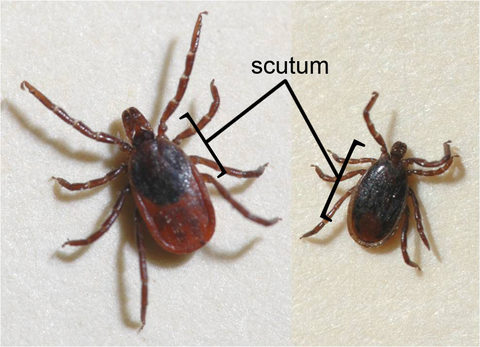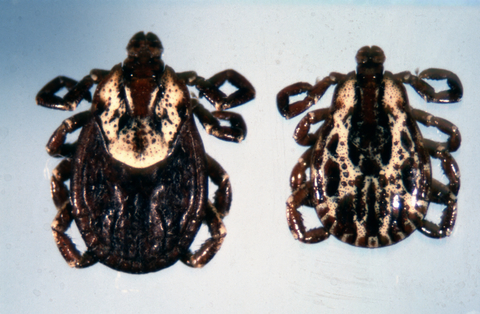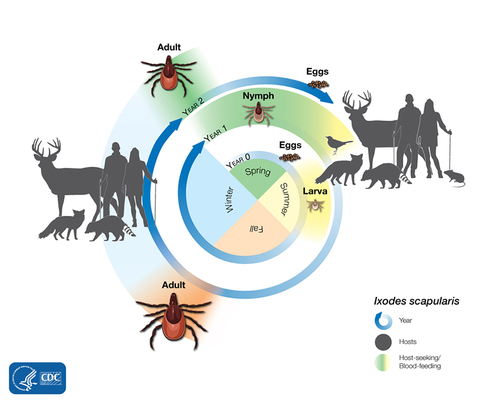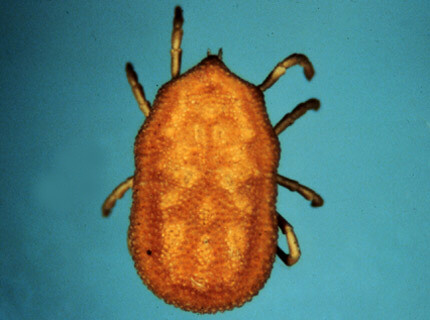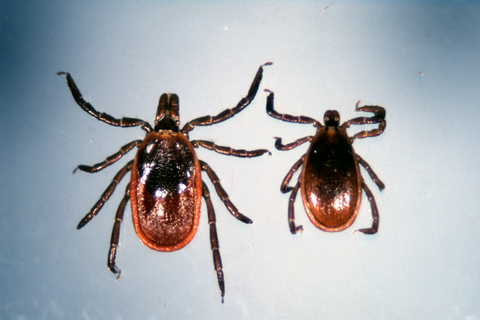Quick facts
- The two most common ticks found by humans are:
- American dog tick, Dermacenter variablis, or wood tick.
- Blacklegged tick, Ixodes variablis (formerly known as deer tick), which carries Lyme disease and other diseases.
- The brown dog tick is also found in Minnesota, but less commonly seen.
- To avoid tick bites:
- When in the woods, walk on trails and avoid moving through grassy areas.
- Wear protective clothing, such as long-sleeved shirts and pants that are light-colored.
- Use repellents like DEET or permethrin.
- Always follow instructions and read warnings on repellent labels.
How to identify ticks
- There are 13 known species of ticks in Minnesota.
- Ticks can be very challenging to identify because of differences in size, gender, age (adult or immature) and whether they have been feeding.
- Color can help, but don’t rely on this in all situations.
- Engorged ticks are particularly challenging to identify as their size and color are greatly changed.
- Adult females are larger than males.
- Adult females have a relatively small scutum (plate-like structure on body) while the scutum in males covers most of their body.
- If there is ever any doubt as to what species of tick you have encountered, send it to an expert for identification.
American dog tick (wood tick)
- Unfed adults are dark brown with whitish or yellowish markings.
- On females these markings cover half of the body and, on males, nearly the entire body
- These marking will be difficult to see on engorged ticks and is not present on immature ticks.
Blacklegged tick (formerly deer tick)
- Adult female blacklegged ticks are reddish brown with a black head, legs and scutum.
- Unfed adults don't have any markings on their bodies.
- The presence or absence of marking will be difficult to see on engorged and immature ticks.
Life cycle
In general, the tick life cycle consists of egg, larva, nymph and adult. A larva has six legs, while nymphs and adults have eight legs.
They look very similar in all stages, although they are usually different colors. Ticks usually feed once in each stage before moving to the next.
American dog ticks (wood ticks)
American dog ticks are most commonly found in spring in open fields and in the underbrush of hardwood forests. They are active throughout summer. They feed on a wide variety of mammals, including white-footed mice, voles, chipmunks, raccoons, squirrels, dogs, cats and people.
- Usually take two years to complete their life cycle.
- During the summer of the first year, the eggs hatch into larvae.
- These larvae do not feed until late spring or early summer the following year.
- After their blood meal, they change into nymphs.
- After feeding a second time, these immature ticks develop into adults during late summer of the second year.
- The adults do not feed until the following spring, when the weather turns warm.
- Adults are common April through June but die after laying eggs, thus completing the life cycle.
Blacklegged tick (formerly deer tick)
Blacklegged ticks are common from spring through fall. Adults are active outdoors even at temperatures as low as the mid to upper 30so F, but tend to be most active in warmer temperatures.
Blacklegged ticks are important because they are a potential carrier of Lyme disease and other diseases.
- They require at least two years to complete their life cycle.
- Larvae begin to hatch in June.
- They feed throughout the summer on white-footed mice or other small mammals or ground-foraging birds.
- They usually spend the winter as nymphs.
- The following year, nymphs take blood meals in spring or early summer, feeding on small mammals, birds or humans.
- They typically turn into adults in late summer.
- Adults take blood meals in the fall or the following spring.
- They feed on white-tailed deer, dogs, horses, raccoons or humans.
- Females die after laying eggs in late spring, completing the life cycle.
-
Soft ticks are typically found around animal burrows and dens, bat caves and homes, especially in attics where bats roost.
-
Compared to hard ticks, they do not attach themselves firmly to hosts and feed more frequently but for much shorter periods of time.
Diseases carried by ticks
The American dog tick in Minnesota can carry Rocky Mountain spotted fever, though this is rare. For more information on Rocky Mountain spotted fever, see information at the Centers for Disease Control and Prevention (CDC).
The blacklegged tick carries Lyme disease and several other diseases. See the Minnesota Department of Health page on tickborne diseases.
High risk areas for tick exposure in Minnesota include the north central, east-central and southeastern regions of the state, also extending into some northwestern counties. Greatest risk is found within hardwood or mixed hardwood forests, which provide suitable habitat for blacklegged ticks.
Risk of bites from these ticks in Minnesota is highest during the spring, early summer, and fall months. Tickborne diseases have been increasing each year in the state.
A blacklegged tick can only transmit disease to humans through a bite. They can't do so by just crawling on a person. Even when biting, a blacklegged tick must stay attached for at least 24 to 48 hours to transmit Lyme disease (12 to 24 hours to transmit human anaplasmosis).
If you want to find out for sure what type of tick you've found, you can fill out a form and send it and the tick to the health department for proper identification. This helps the state monitor where ticks are active.
Check this map to see where blacklegged ticks have been found in the state.
Lyme disease is the most common of all the tick diseases. It is a potentially serious bacterial infection caused by Borrelia burgdorferi, and can infect humans and animals. It can be treated with antibiotics.
Symptoms:
- Some people may not develop any symptoms of illness.
- About 70 to 80 percent of people with Lyme disease develop an erythema migrans (EM) rash made of spots that are red welts, sometimes with purple or blistered areas in the center.
- Fever and other symptoms can develop if left untreated. People often feel like they have the flu.
- Symptoms occur about 3 to 30 days after a tick bite.
- If left untreated, Lyme disease can eventually include chronic fatigue, joint swelling in one or more large joints, or neurologic signs.
Other less common diseases
-
Anaplasmosis, formerly known as HGE or HGA, is caused by Anaplasma phagocytophilum bacteria.
-
Symptoms: Fever, chills, headache, and muscle ache may develop 5-21 days after a bite from an infected tick.
-
-
Babesiosis is caused by the Babesia parasite and often does not show symptoms. It can be treated with antimicrobial drugs.
-
Symptoms: It can cause fever, muscle aches, headaches, nausea and anemia.
-
-
Powassan encephalitis is caused by the Powassan virus. There are no vaccines or medications to treat or prevent Powassan encephalitis. People with severe cases need to be hospitalized. It is very rare in Minnesota.
-
Symptoms: Fever, headache, nausea, loss of memory and difficulty speaking. Long-term effects have been reported to be common and are potentially severe.
-
-
Dogs are most commonly identified with tickborne diseases.
-
Dogs exposed to Lyme disease may not show any signs of illness.
-
Some may develop fever and lameness.
-
Anaplasmosis can cause fever, lethargy and bleeding disorders. One of the most common findings in canine anaplasmosis is low platelet counts.
-
If you recognize any of these symptoms, call a veterinarian.
-
-
Horse owners should be alert to tickborne diseases, especially anaplasmosis, which can be severe.
-
Signs and symptoms include fever, loss of appetite, listlessness and limb swelling.
-
How to control ticks and prevent tickborne diseases
Personal protection
-
When in the woods, walk on trails and avoid moving through grassy areas. Ticks are usually found in brush and low-lying vegetation near the forest floor.
-
Wear protective clothing, such as long-sleeved shirts and pants that are light-colored.
-
Use repellents like DEET or permethrin. Permethrin is a repellent that is sprayed on clothes and stays for several washes.
-
Dog owners in the Upper Midwest should use topical tick preventatives from March through November.
-
It is very important to check yourself for ticks after you have been in tick-infested areas.
-
Several Lyme disease vaccines are available for dogs. Consult your veterinarian to determine if your dog should be vaccinated.
-
If you do find a tick attached to your skin, carefully remove it with tweezers.
-
Grasp it around the head as close to the skin as possible and gently yet firmly pull it out.
-
Save any ticks that are found biting so an expert can identify them later.
-
Only blacklegged ticks are known carriers of human disease in Minnesota.
-
In your yard
The numbers of ticks found on a property are influenced by the amount of favorable habitat that is found there (brushy, grassy areas) and the number of animals, especially whitetailed deer and whitefooted mice, that are present.
You can reduce tick numbers by modifying your landscape to create a less favorable environment for ticks and their animal hosts.
- Keep grass and vegetation short around homes, where it borders lawns, along paths and in areas where people may contact ticks. Ticks are less likely to survive in short grass.
- Remove leaf litter and brush, especially from buffer areas where the lawn borders grassy, brushy areas.
- Also prune trees and shrubs in these areas to allow more sunlight through as ticks are more common in shaded areas.
- You may be able to reduce the number of ticks near your home by reducing the number of deer that are nearby, although this usually very challenging.
- Do not encourage deer into your yard by feeding them.
- Fences can help reduce the number of deer that enter into your yard, but will have to be sufficiently high enough, about 8 to 10 feet tall.
- Try to avoid plants that deer particularly like to eat.
- It is not effective to treat large areas of woods, brush or grass with insecticides as they do not always reach into areas where ticks are found (in the leaf litter).
- Ticks can also be reintroduced into areas when animals and birds carrying ticks move into previously treated areas.
- It is not necessary to treat your lawn for ticks as ticks rarely infest maintained yards.
- When high numbers of ticks are present in areas near home yards, treating the edges of wooded or brushy areas and paths with insecticides can help to reduce tick numbers.
- Use an insecticide labeled for a turf area, such as those containing permethrin, cyfluthrin or carbaryl.
-
It is important to first treat your dog for ticks.
-
Use insecticide sprays in and outside of the house to control their movement.
-
Inside the house spray areas like the floor, baseboards, and higher up on walls to control the ticks.
-
Eliminate the bats from the building.
-
Identify and seal all entrances after the bats have left. The best time to do this is late summer and fall.
-
If the ticks remain you can use an insecticide like permethrin, bifenthrin, lambda cyhalothrin or tralomethrin.
CAUTION: Mention of a pesticide or use of a pesticide label is for educational purposes only. Always follow the pesticide label directions attached to the pesticide container you are using. Be sure that the area you wish to treat is listed on the label of the pesticide you intend to use. Remember, the label is the law.
Reviewed in 2019


